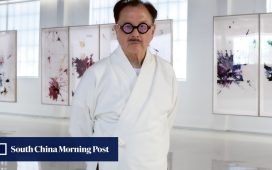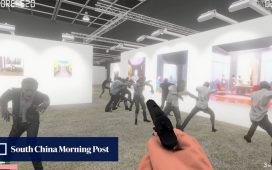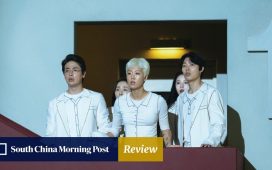The exhibition, which runs until July 14, was curated by the Chat team and features textile works, installations, sculptures and videos from 19 Asian artists.

While some have been drawn from Chat’s own collection of contemporary art, others were newly commissioned; all use textiles and materials in some way or form to address topics of concern today, such as sustainability, climate change and ecology.
Among the first works visitors see in the gallery space is South Korean artist Park Jeehee’s Drawing Elliptical Orbit (when the half-moon sets in late summer) (2022), for which the centrepiece is an abstract organic resin sculpture tinted with yellow, orange and brown.

Made with pigment extracted from mould samples which the artist first found in the area around The Mills in 2021 and later cultivated over time, the work acts as a living time capsule that brings the past into the present.
Another notable work is Japanese artist Takahiro Iwasaki’s Out of Disorder (In Flux) (2018), which features a bed of raw cotton and several cotton fabric sculptures suspended from a fishing net from above – a nod to The Mills’ past life as a cotton-spinning factory and Hong Kong’s history as a fishing community.
It depicts aspects of Hong Kong’s urban landscape, including neon signs, construction cranes and the Hong Kong Observation Wheel.

Among the other artists whose work features in “Factory of Tomorrow” is Indonesian Ade Darmawan – director of the art collective Ruangrupa – whose artwork Patchwork Regulation (2019) is a collection of carpets and hand-tufted rugs that highlight Hong Kong’s social, political and economic trajectories.
Meanwhile, Yuki Kihara’sサ-モアのうた (Sāmoa no Uta) A Song About Sāmoa – Fanua (Land) (2021) features a set of five painted kimonos that collectively serve as a critique of neoliberal capitalism and tourism’s negative impact on the environment.
Among the newly commissioned works in the exhibition is Hong Kong artist Maggie Chu’s Entwined Nexus – urban synapse (2024).

A trained architect, Chu has incorporated folding architecture – where 2D surfaces are transformed into 3D forms using origami – into a tapestry that shows a speculative model of Hong Kong where creativity is emphasised.
“I’m trying to look at some big issues, like city structure, culture and society, but then [present] it in an intimate, personal scale that we can understand, that we can relate to,” Chu says.
Instead of focusing on Hong Kong’s finance and commercial hubs, she shifts visitors’ attention to former industrial areas such as Tsuen Wan, Wong Chuk Hang and Fo Tan, all of which have become creative arts centres. She likens the neighbourhoods’ adaptability and connections to those seen in our natural environment.

“I’m trying to draw that connection between the urban and the nature,” the artist says, which is why some of the folded paper structures look like birds, while one looks like a jellyfish.
Another striking installation in “Factory of Tomorrow” is Japanese artist Yuki Kobayashi’s Factory of Universe (2024), which features three walls covered with crimson fabric and a floor filled with thick, noodle-like strands and furry head coverings in the same colour.
The work is an offshoot of Kobayashi’s 2012 video work Maybe I Am a Strawberry, which is also on view and follows the artist across London as he adopts the persona of a strawberry.

“I’m camouflaging myself,” he says, and explains that the exercise was an instinctual response to his personal struggles with gender and race. He says it allowed him to simultaneously protect and explore his identity, because he could be more free and open towards others.
“Those kinds of conflictions in myself – the strawberry is, for me, a metaphor. [It’s] juicy, fragile and also feminine,” he says. “As a strawberry, I’m no one but I can be anyone.”
Since 2012, Kobayashi has expanded the concept with photography, video and installations, inviting others to “find their own strawberry” and enter a safe space where they are not beholden to predetermined social roles.

“It started from sexual orientation and those conflictions, but from that moment on I expanded to racial discrimination issues, and also disability – those social issues,” he says. “You can create your own place to be yourself or protect your identity.”
During the artist’s three-month residency at Chat at the end of 2023, he made several visits to the Ebenezer School and Home for the Visually Impaired in Pok Fu Lam on Hong Kong Island, where students were invited to play with the noodle-like structures that he made with textiles sourced from Sham Shui Po in Kowloon.
At the end of the workshop, Kobayashi asked each student to pose with them – some chose to hold and lift the structures, others chose to swing and hug them; the artist strung their poses together as a script for the performance seen in the installation’s video.

And in Chat’s D. H. Chen Foundation Gallery, there is a new display curated by Bruce Li titled “Misfitted: Unspoken Stories of Tailoring”, which uses archival clothes, objects and materials to shed light on five forms of Hong Kong tailoring that have traditionally been overlooked.
These include bespoke dresses made by an amah, contemporary dance costumes made by a wardrobe mistress, and custom uniforms for foreign servicemen made by Fu Shing & Sons tailors in Hong Kong’s Central neighbourhood.


“Tailoring was a very important part in Hong Kong people’s daily life in the past,” Wang says. “It has a very strong so-called Hong Kong spirit.”
“Factory of Tomorrow”, 2/F, The Mills, 45 Pak Tin Par Street, Tsuen Wan, Wed-Mon 11am-7pm. Until July 14.






